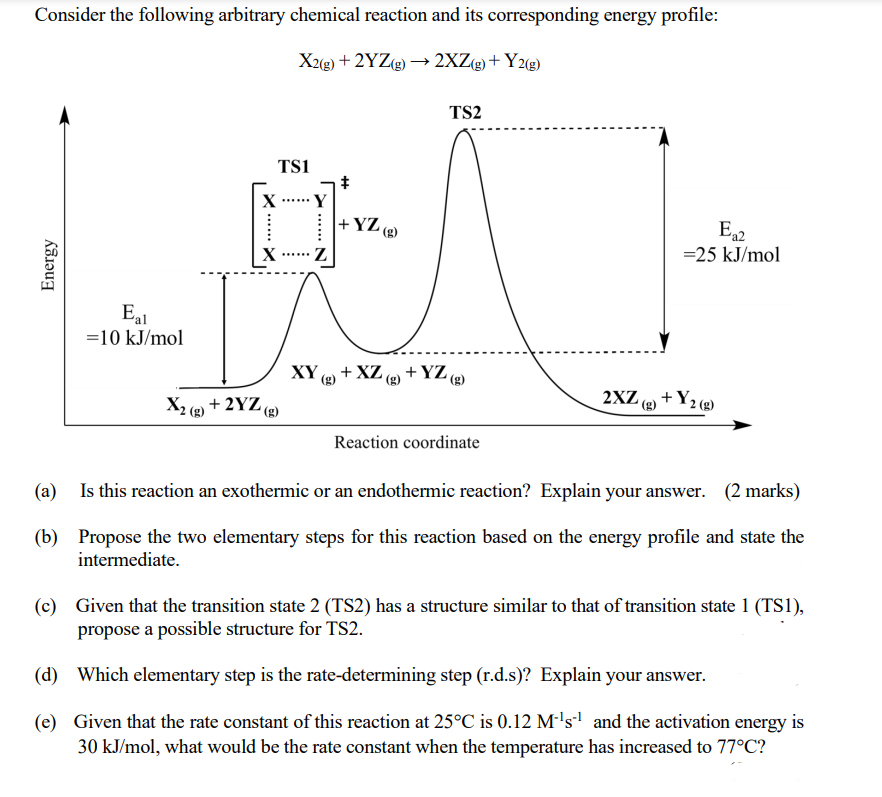(a) Is this reaction an exothermic or an endothermic reaction? Explain your answer. (2 marks) (b) Propose the two elementary steps for this reaction based on the energy profile and state the intermediate. (c) Given that the transition state 2 (TS2) has a structure similar to that of transition state 1 (TS1), propose a possible structure for TS2.
(a) Is this reaction an exothermic or an endothermic reaction? Explain your answer. (2 marks) (b) Propose the two elementary steps for this reaction based on the energy profile and state the intermediate. (c) Given that the transition state 2 (TS2) has a structure similar to that of transition state 1 (TS1), propose a possible structure for TS2.
Chapter17: Spontaneity, Entropy, And Free Energy
Section: Chapter Questions
Problem 23Q: Monochloroethane (C2H5Cl) can be produced by the direct reaction of ethane gas (C2H6) with chlorine...
Related questions
Question
( plz a b c with detail explanation )

Transcribed Image Text:Consider the following arbitrary chemical reaction and its corresponding energy profile:
X2(g) + 2YZ@) –→ 2XZg) + Y2g)
TS2
TS1
X
Y
+YZ (g)
E2
=25 kJ/mol
Eal
=10 kJ/mol
XY () + XZ () +YZ (2)
' (g)
+Y2 «g)
2XZ (g)
X2 (2) + 2YZ g)
Reaction coordinate
(a) Is this reaction an exothermic or an endothermic reaction? Explain your answer. (2 marks)
(b) Propose the two elementary steps for this reaction based on the energy profile and state the
intermediate.
(c) Given that the transition state 2 (TS2) has a structure similar to that of transition state 1 (TS1),
propose a possible structure for TS2.
(d) Which elementary step is the rate-determining step (r.d.s)? Explain your answer.
(e) Given that the rate constant of this reaction at 25°C is 0.12 M-'s-' and the activation energy is
30 kJ/mol, what would be the rate constant when the temperature has increased to 77°C?
++
.....N
Energy
Expert Solution
This question has been solved!
Explore an expertly crafted, step-by-step solution for a thorough understanding of key concepts.
Step by step
Solved in 2 steps

Knowledge Booster
Learn more about
Need a deep-dive on the concept behind this application? Look no further. Learn more about this topic, chemistry and related others by exploring similar questions and additional content below.Recommended textbooks for you


Chemistry
Chemistry
ISBN:
9781305957404
Author:
Steven S. Zumdahl, Susan A. Zumdahl, Donald J. DeCoste
Publisher:
Cengage Learning

Chemistry: An Atoms First Approach
Chemistry
ISBN:
9781305079243
Author:
Steven S. Zumdahl, Susan A. Zumdahl
Publisher:
Cengage Learning


Chemistry
Chemistry
ISBN:
9781305957404
Author:
Steven S. Zumdahl, Susan A. Zumdahl, Donald J. DeCoste
Publisher:
Cengage Learning

Chemistry: An Atoms First Approach
Chemistry
ISBN:
9781305079243
Author:
Steven S. Zumdahl, Susan A. Zumdahl
Publisher:
Cengage Learning

Chemistry: The Molecular Science
Chemistry
ISBN:
9781285199047
Author:
John W. Moore, Conrad L. Stanitski
Publisher:
Cengage Learning

Chemistry & Chemical Reactivity
Chemistry
ISBN:
9781337399074
Author:
John C. Kotz, Paul M. Treichel, John Townsend, David Treichel
Publisher:
Cengage Learning

General Chemistry - Standalone book (MindTap Cour…
Chemistry
ISBN:
9781305580343
Author:
Steven D. Gammon, Ebbing, Darrell Ebbing, Steven D., Darrell; Gammon, Darrell Ebbing; Steven D. Gammon, Darrell D.; Gammon, Ebbing; Steven D. Gammon; Darrell
Publisher:
Cengage Learning